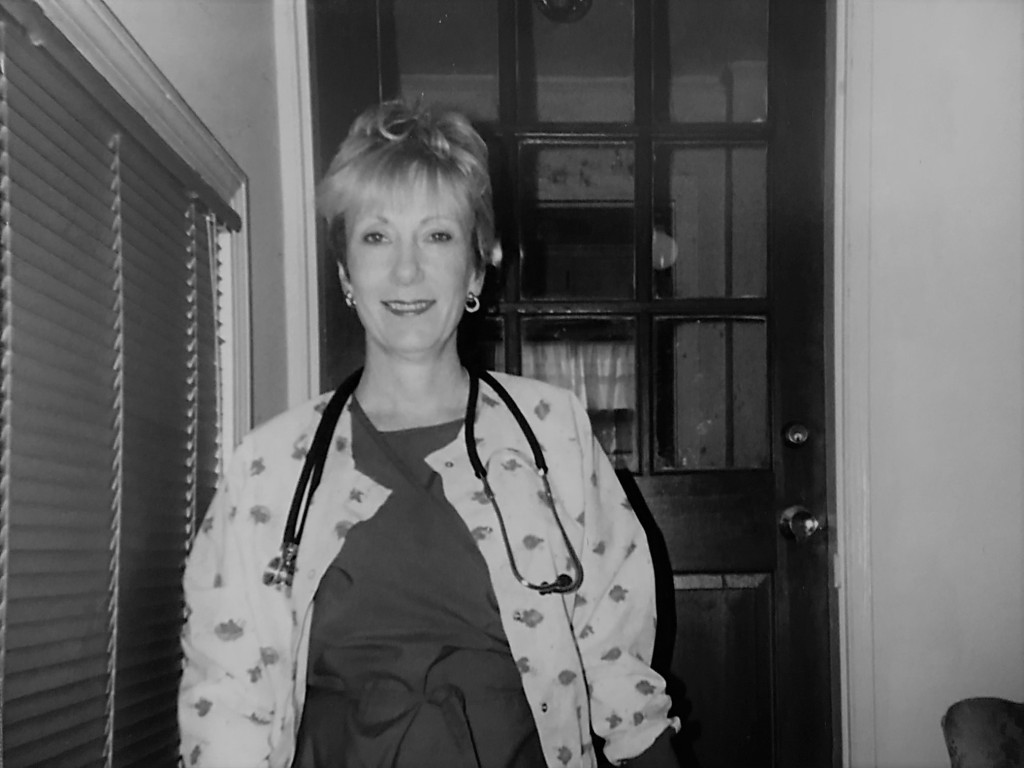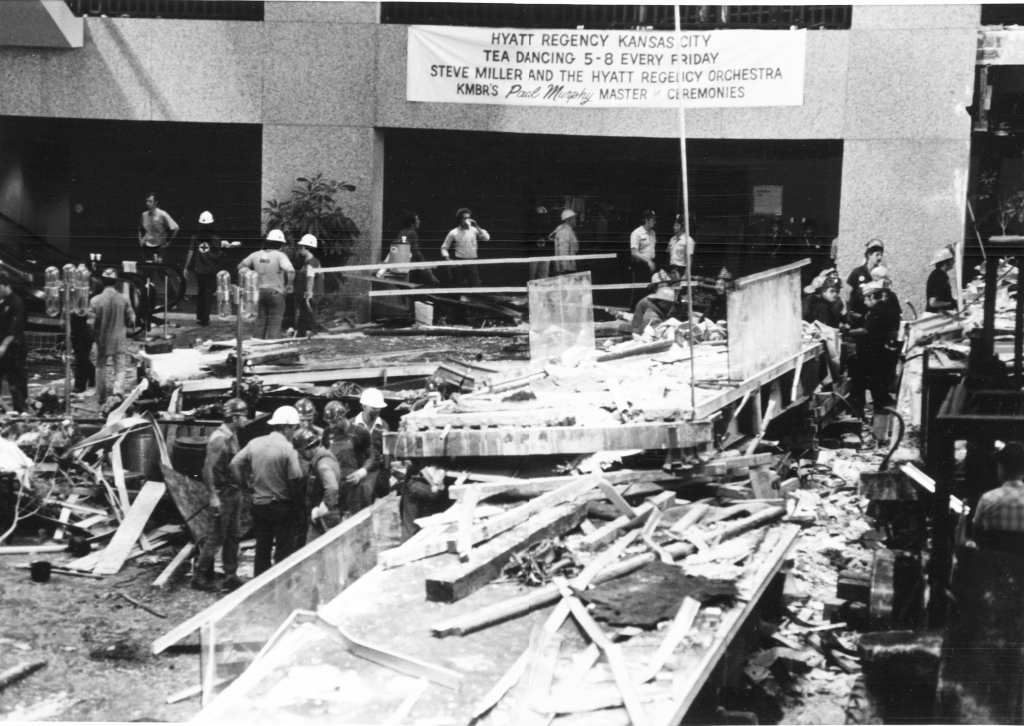R. Eli Paul is the former director of the Missouri Valley Special Collections at the Kansas City Public Library. His public history career has spanned four decades, including previous tenures at the Nebraska State Historical Society, Heinz History Center in Pittsburgh, and the National World War I Museum. Paul is the author or editor of several books, including Eyewitness at Wounded Knee (Nebraska, 2016), Autobiography of Red Cloud: War Leader of the Oglalas, and Blue Water Creek and the First Sioux War, 1854–1856. His book Skywalks: Robert Gordon’s Untold Story of Hallmark’s Kansas City Disaster (Bison Books, 2023) was published in March.
Anniversaries are the unfinished business of history. On a summer’s Friday evening of July 17, 1981, two suspended walkways, or “skywalks,” in Kansas City’s newest, most exciting hotel pulled loose from their roof supports. More than sixty tons of steel, concrete, and glass crashed below on hundreds of people attending a dance. Of the more than 1,500 present in the Hyatt lobby where the disaster occurred, 114 died from their injuries, most immediately. More than two hundred suffered injuries, some trapped for hours.
First responders struggled amidst the rubble and chaos, sometimes resorting to emergency amputations to free victims. Journalists rushed in and captured the hellish scene with words, photographs, and videotape, the most gruesome of which were never shared with the public. All agreed: it was the worst structural failure in the nation’s history and the worst thing that ever happened in Kansas City.
One year later the city struggled with the anniversary. Many wanted the day to pass quietly, among them the mayor, who had served as a stretcher bearer during rescue efforts. He thought people should “be aware of the date and handle it in their own individual way.” Others, including those with pending lawsuits against the hotel builders, wanted the spotlight to remain on the tragedy. These forces – moving on versus commemoration – lingered in their quiet opposition for decades.
Not until 2006, the twenty-fifth anniversary, did formal efforts commence to memorialize the event. In 2011, the thirtieth, a site for a memorial near the hotel was chosen, and fund-raising began in earnest. In 2015 a memorial park and outdoor sculpture were dedicated, which accommodated in 2021 a large, public observance of the fortieth anniversary of “Hallmark’s Kansas City disaster.”
This July 17 was a quieter anniversary, handled in one’s “own individual way,” and because of that – and as the author of Skywalks – I had a series of interesting encounters.
First, in the morning I answered a call from someone who, without any prelude that I caught, started talking about the Hyatt disaster. All that initially registered was “McCoy.” It turned out to be Bernard “Barney” McCoy, professor of Journalism at the University of Nebraska-Lincoln, someone I did not know, although I knew of his father, long-time Kansas University professor and historian Donald McCoy.
Barney wanted to tell me about where he was on July 17, 1981. As a 25-year-old, on-camera reporter for KCTV-5 news, the local CBS affiliate, he covered the story that night. He also wanted to send me the link to a story he did for KCTV when he returned on the 30th anniversary (2011), long after his departure from KC. (It was a very well-done piece.) Barney congratulated me on the new book, and we had a nice chat. I learned that it was not just the survivors and first responders who subsequently suffered from PTSD; he had suffered his own bout, particularly at the time of the first anniversary. It seemed as if he needed to share the day with someone who would understand.
Shortly after this, Molly Riley called. She was the Hyatt attendee-survivor-first responder-nurse-class action representative who figures prominently in Skywalks. We had not spoken on the phone since our last interview. She, too, needed someone to talk to about that day because she “wasn’t doing so well.” Anniversaries of the disaster were always difficult for her, and she sounded tearful during most of our conversation.
Molly had a favor to ask. Could I help find her friend Gaye, who was with her that night? They met at the Hyatt, walked around together, and sipped drinks on one of the skywalks while looking down on the crowded dance floor. They had hoped to grab a table under the skywalks, but the packed crowd prevented that. At about 7 p.m. they decided to leave. Molly walked under the skywalks to drop off her empty glass on a table, Gaye with her. She turned around and walked a few steps before it all crashed down behind her. Stunned, she looked around for Gaye, did not see her, and presumed her dead. Then her nurse’s duty kicked in, and she began to help the victims. Hours later, as she left the hotel, Gaye was outside waiting for her.
Molly told me that they had lost touch, and asked if I knew her whereabouts. I did not but would try. After a day’s long internet search that I won’t bore you with, I found Gaye. Now living a few miles away from Molly, with a KC address, three phone numbers, and a new surname. Molly later told me that she had reached out but had not yet received a response from her old friend.

Finally, the HR office of the Kansas City Public Library, my last employer, told me that a survivor wanted to get in touch. I had no name or address or phone number, only an email address, which turned out to be garbled and bounced back after I sent a message. After another, lengthy and lucky bout of internet sleuthing, I tracked down Janet Gelb, who was “severely injured that night with a broken back, smashed organs, buried but am actually in good shape thanks to my dad. He was a veterinarian, challenged the surgeons and basically saved my life.”
Janet does not appear in my book, nor that of Robert Gordon, my legal protagonist in Skywalks. She barely appeared in the local newspaper, listed post-collapse with her current medical status, along with dozens of other victims. She spent a month in the hospital before her release. Her settlement with the defendants was settled without a court case and with no publicity.

We have had a nice, email correspondence since then. Once again it was the anniversary that prompted the need to talk about this to someone who could appreciate and understand. Janet had the book on order, later had it in hand, and wrote, “Oh, this book is so good! I am having trouble putting it down.” Music to an author’s ears.
Reflecting on that day with Barney, Molly, and Janet, I realize the power that anniversaries, those annual bouts of unfinished business, holds on all of us. We need these touchstones of our collective past, even if we observe them privately and voice them in our own way. It also helps if someone is out there, an available author perhaps, to listen to what is said about that day.

2 thoughts on “From the Desk of R. Eli Paul”